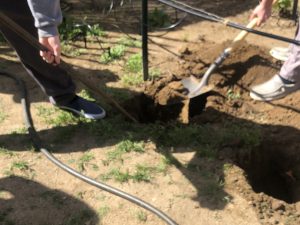Standing in front of the refrigerator with the door open, just perusing the view? Tasty choices are everywhere! Just get up and get them.
Many living beings on this earth can move to find nutrients. Movement gives us the ability to eat different kinds and better quality of food. Movement also provides better water to drink. The freedom of movement separates us from those rooted into the earth.
Plants are dependent on Mother Nature and the people who care for them. With roots deep in the soil, a plant’s success depends on how tasty (or beneficial) the nutrients in the soil are.
Dirt is dirt whether it is at your house or at the neighbor’s three doors down. But, the quality of that dirt has everything to do with the health of the plants in your yard. Dirt is made from individual ingredients (just like your Aunt Susan’s Super-Secret Pound Cake). Mother Nature has a very organized formula for soil. Everyone’s dirt is composed of minerals, organic materials, air, and water. The ratio of these four components will determine whether your soil is tasty or toxic.
Minerals are produced from constant breakdown of rocks over thousands of years. Organic material is decomposing plants and animals that create tasty food for the living organisms under your feet. Earthworms, fungi, and bacteria all excrete plant nutrition. Dirt, in order to be a good host to its partner, plants, must have pore areas – open spaces filled with either air or water.
The best Western soil has 50% solid materials and 50% pore space (divided into half water and half air). Just as with everything else on earth, healthy soil must eat, breathe, and drink. Our California soil is labeled mineral soil because of the high percentage of minerals versus organic materials. Organic material content is often less than 20% and frequently less than 5%. This unbalanced ratio creates plant hardship that may not be recoverable. To achieve the best balance of the four components in your soil some testing may be required.
There are tricks to discovering your soil’s benefits or downfalls. When you are ready to plant, dig a hole and fill it with water. If water does not absorb back into the ground within 24 hours your soil is heavy and claylike. The choice? Continue digging, if water remains, until you break through, allowing drainage. Otherwise, you are planting in a bowl where your plant will drown. Back to ratios, heavy soil provides little or no air space or organic material. Bad ratios start your plant on a death march.
There are 17 nutrients that plants need; 14 are absorbed through the soil and 3 from air and water. When a plant is not doing well, it will show symptoms for you to research. There are publications, internet sites, and diagnostic labs that will assist in providing answers. Some corrections are easy, like adding inorganic fertilizers or amendments to provide necessary nutrients. Symptoms may be confusing and multiple treatments may be required. Your local nursery and Master Gardeners are excellent sources for help.
Julie Silva is a University of California Cooperative Extension Master Gardener of Tuolumne County.

